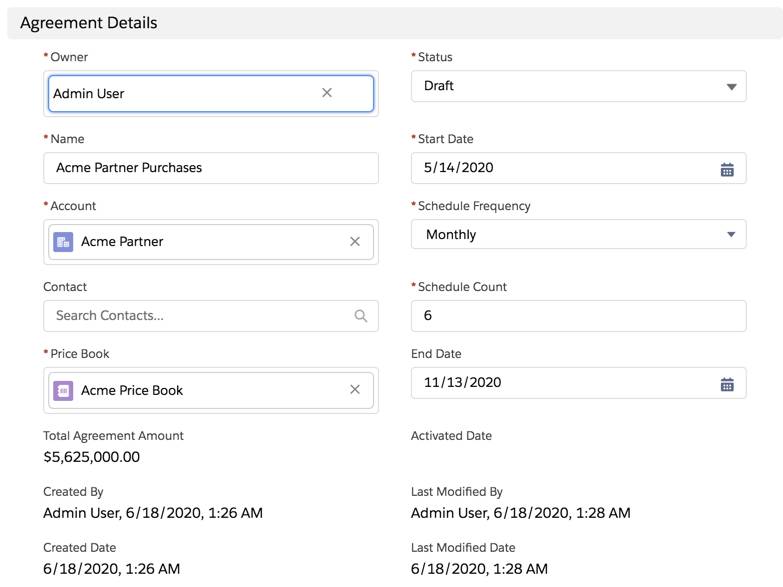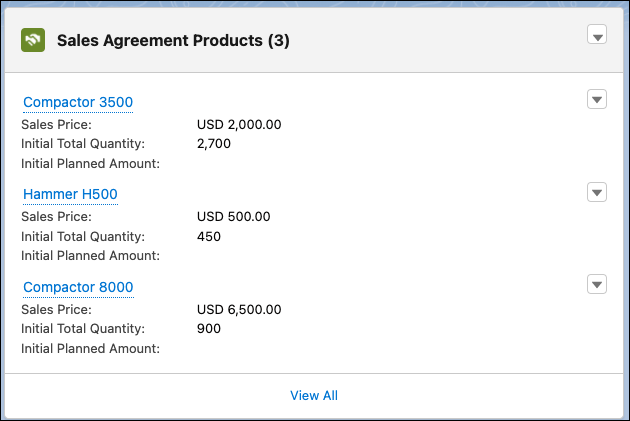Create a Sales Agreement
Learning Objectives
After completing this unit, you’ll be able to:
- Create a sales agreement in Manufacturing Cloud.
- Associate products or categories with a sales agreement.
- Explore the Agreement Terms tab.
Negotiate Terms with Sales Agreements
Vance has just completed an intense meeting with Paula Zhu, a distributor for Acme Partner. Here are a few takeaways for Vance from the meeting.
- New sales agreement: Rayler Parts has recently launched a new product, the Compactor 8000, and it’s generating a lot of the buzz in the market. Paula is keen to source this equipment from Rayler Parts because her customers are really interested in it.
- Change in pricing: Paula wants Vance to look into pricing of two additional products, the Compactor 3500 and the Hammer H500, in the new sales agreement. Acme Partner wants to buy these products in bulk for the next 6 months and a discount will be appreciated!
- Urgent order placement: Acme Partner doesn’t want to waste time, and wants Rayler Parts to ship the first order immediately. Vance must activate the agreement and create orders in advance to account for this.
Vance gets down to business. He has all the information he requires from Paula, and it’s time to create a sales agreement. Here’s what he does.
- Click
 , and find and select Sales Agreements. (You can also find and select the Manufacturing app from the App Launcher and select Sales Agreements from the navigation bar.)
, and find and select Sales Agreements. (You can also find and select the Manufacturing app from the App Launcher and select Sales Agreements from the navigation bar.) - Click New.
- The Owner field is auto-populated with the name of the current user.
- For name, enter
Acme Partner Purchases.This is the sales agreement name, and it must be unique. - For Account, search for and select Acme Partner.
- For Price Book, search for and select Acme Price Book.
- For Product Level, search for and select Product.
- For Status, select Draft. Note that you always create a sales agreement in draft state.
- For Start Date, select a date that is one month back from today’s date. This becomes important later in the module when you walk through renewing the sales agreement.
- For Schedule Frequency, select Monthly.
- For Schedule Count, enter
6. This is the number of schedules (or months, in this case) for which the sales agreement is active. - Click Save. Manufacturing Cloud automatically calculates the end date based on your start date, schedule frequency, and schedule count.

Vance has now created a sales agreement with a 6-month term. After Vance and Paula review the sales agreement in an upcoming meeting, Vance can approve it. Manufacturing Cloud automatically activates an approved sales agreement when it reaches its start date, and automatically expires the agreement on the end date. Vance can cancel, expire, or delete the sales agreement at any point during these 6 months. Also, Vance can renew a sales agreement starting 240 days before the end of the agreement.
Add Products to the Agreement
Vance now adds products to the sales agreement per Acme Partner’s requirements.
- On the Acme Partner Purchases sales agreement record page, click
 on the Sales Agreement Products card. Click Add Products.
on the Sales Agreement Products card. Click Add Products. - Search for and select these products:
- Compactor 3500
- Hammer H500
- Compactor 8000
- Click Next.
- The list prices populate both the List and Sales Price fields by default from the price book you associated with the sales agreement. In the Sales Price column, adjust the pricing by clicking in a field and updating it to the new sales price per unit:
- Compactor 3500:
$2,000 - Hammer H500:
$500 - Compactor 8000:
$6,500
- Compactor 3500:
- Enter the Initial Total Quantity for each product (this is equally distributed across all schedules):
- Compactor 3500:
2,700 - Hammer H500:
450 - Compactor 8000:
900
- Compactor 3500:
- Scroll to the right and add a Discount Percentage for the Compactor 8000.
- Compactor 8000: 10
- Save your changes.
Vance thinks of this discount like shopping at a bulk-purchase store: The more you buy, the higher your discount. But he also wants to be careful to protect his revenue margins. Acme Partner has just agreed to buy the Compactor 8000 for 6 months, and a 10% discount to promote the new product seems reasonable to Vance.

Vance looks at the sales agreement and is amazed to see the amount of data at his fingertips. On the Agreement Terms tab, he scrolls right and sees that the initial total quantity for each product has been distributed across the 6 months. He can also see the sales prices and discounts for each product. He now has all the information he needs to have productive discussions with Paula and other distributors for Acme Partner.
A Few More Options
We saw how Vance created a sales agreement and added a few products to it. He can also add product categories. Rather than adding one product at a time, Vance can set the Product Level for the sales agreement as Category and add one or more product categories using the Sales Agreement Products card or the Add Category action in the Related tab.

When orders are associated with the sales agreement, the application checks the order product. Based on the primary product category associated with the product, the actual quantity and actual amounts are updated in the sales agreement against the relevant product category rows. This flexibility helps account managers in two ways:
- If you have a sales agreement with multiple products of more than one category, add the categories directly to the sales agreement. Edit and remove the products you don’t want from the category list.
- If you’re a demand planner and want to track the planned versus actual quantities and amounts for products at a category level for reporting purposes, do that with a category-level agreement.
While on the Agreement Terms tab, Vance notices a few more actions which he explores.
- Filter: For an agreement spanning multiple products and schedules, an account manager can filter the agreement terms by either product, product category, or time period to easily drill down to the required data.
View the data for the current period, a range of periods like May ‘21 to Dec ‘21, or for a set of periods like May ‘21, June ‘21, and July ‘21.
- Expand: Scrolling through a long table of product quantities, prices, and amounts over multiple periods can be difficult. With this action, the agreement terms pops open in a new view for easy editing.
- Refresh: Refresh the agreement terms to see the latest values in real time.

Vance can’t wait to explore more—he sets up a meeting with Paula to discuss the next steps.